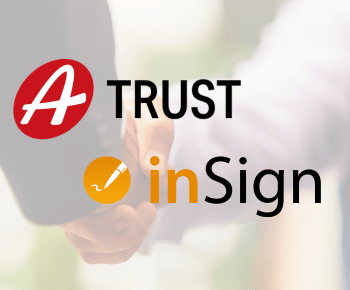
Electronic signature vs. handwritten signature on paper
Digitalisation is advancing in great strides. Big Data, artificial intelligence and innovative technologies are being used with increasing frequency, including the electronic signature. This is intended to replace the paper signature and enable a location- and time-independent way of working. In this article, we take a closer look at the benefits and disadvantages of the electronic signature.
Advantages
Digitise business processes, shorten lead times
With an e-signature, many business processes can be digitised and signatures can be obtained completely independent of time and place. The processing time of signature workflows is significantly shortened, since, for example, sending the documents by post or travelling to the customer is no longer necessary.Work environmentally friendly
The digital signature makes a valuable contribution to protect the environment by means of conserving resources such as water and trees. Did you know that a standard pack of copy paper (500 sheets DIN A4, 2.3 kg) uses 7.5 kilograms of wood, 130 litres of water and 26.8 kilowatt hours of energy?Save time & costs
The electronic signature saves on costs for paper, printer and other supplies such as ink or toner. But an e-signature can also reduce the need to travel to the office or customer.Better organisation
Some signature providers offer a document management and/or a digital archive for signed documents to prevent them from getting lost. Also, performing a digital search is usually easier than a physical one involving archives or folders containing written con-tracts.Increase customer satisfaction
Customers prefer convenience and, therefore, sign contracts with e. g. insurance, electricity and mobile phone providers by choice from home.Strengthen the corporate image
The electronic signature is modern, sustainable and keeping up with the times. This allows you to present yourself both internally and externally as a modern and environmentally friendly company.Protection against tampering
After signing the content of the document must not be changed. Subsequent attempts to manipulate documents by adding text or pages usually go unnoticed at first glance. The electronic signature protects the document against tampering. Subsequent changes are therefore impossible or immediately visible.Original quality – even after many years
Since the retention period of important documents is usually more than 10 years, it must be ensured that the signature is still easy to read afterwards. A signature on paper can fade over time. A handwritten electronic signature, on the other hand, still has original quality even after many years. Other forms of electronic signatures are also not subject to any ageing process.Disadvantages
Different verification value of the signature types
The electronic signature can be divided into three types. There is the simple (SES), advanced (AES) and qualified electronic signature (QES). Although the simple electronic signature is faster and easier to execute, it is not the best choice for all use cases, as this form is more difficult to verify than the advanced- or qualified electronic signature. A few documents, such as fixed-term employment contracts and guarantees, require a qualified electronic signature by law. Therefore, it is important to ascertain which form you require in advance.Technical know-how necessary
The electronic signature may take some getting used to for less technically savvy people, or may even be met with scepticism. In addition, there may be questions raised about the legal certainty of the signature and how the signature process works.Technical infrastructure required
The digital signature requires a minimum of technical infrastructure such as a computer with internet access. Some providers also require an additional device such as a signature pad or smartphone.Software costs
If additional software is required, it is usually subject to a charge. The functions associated with free tools are usually only sufficient for a one-time electronic signature for b>private purposes.
Conclusion
The electronic signature is an important component for a company’s digital transformation and it will soon be impossible to imagine everyday business without it. The costs incurred by the software are fully compensated by savings in time, money and resources. The technical expertise and associated infrastructure can be a challenge, but this usually only affects a small proportion of signatories.
The software solution inSign is aimed at all company sizes, the self-employed and freelancers. Interested parties can choose between three licensing models which differ in terms of the scope of functions and price.

About the author
Christina Detling – Online Marketing Specialist
Christina has been working at inSign for over four years and is happy to pass on her knowledge of electronic signatures and digitisation.
- Further articles
More on the topic of digital signatures



